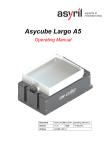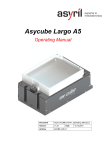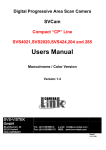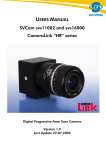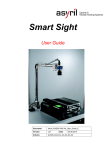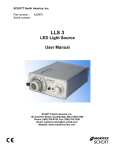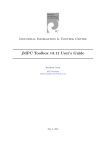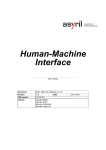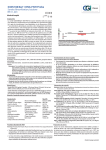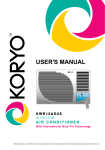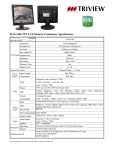Download Operating Manual
Transcript
Asyview Operating Manual Document Asyril_AVIEW-XXX-XX_Operating_Manual_E Version v1.1 Articles AVIEW-XXX-XX--XX-XX-XX-XX Date 19.11.2012 Asyview - Asyril SA Operating Manual Introduction v1.1 © Copyright Asyril S.A. FO 32.03.118 Table of Contents 1. INTRODUCTION ............................................................................................................................... 5 1.1. GENERAL INFORMATION ........................................................................................................... 5 1.2. SAFETY INSTRUCTIONS ............................................................................................................ 6 1.2.1. General instructions ............................................................................................................. 6 1.2.2. Specific instructions.............................................................................................................. 7 2. 1.3. W ARRANTY INFORMATION ........................................................................................................ 8 1.4. OTHER MANUALS ...................................................................................................................... 8 DESCRIPTION .................................................................................................................................. 9 2.1. PRODUCT OVERVIEW ................................................................................................................ 9 2.2. GENERAL CHARACTERISTICS ................................................................................................. 11 2.2.1. Technical data ..................................................................................................................... 11 2.2.2. General dimensions ........................................................................................................... 12 2.3. VISION PERFORMANCE LEVELS .............................................................................................. 13 2.3.1. Different types of lighting ................................................................................................... 13 2.3.2. Asycube lighting .................................................................................................................. 13 2.3.3. Control camera lighting ...................................................................................................... 14 2.3.4. Detection limit ...................................................................................................................... 16 2.4. ELECTRICAL INTERFACES ....................................................................................................... 18 2.4.1. Vision PC ............................................................................................................................. 18 2.4.2. Connection to the Human-Machine interface (HMI) ...................................................... 19 2.4.3. Power connection ............................................................................................................... 20 2.5. MECHANICAL INTERFACES ..................................................................................................... 20 2.5.1. Vision PC and Vision Box .................................................................................................. 20 2.6. ACCESSORIES AND OPTIONAL MODULES ............................................................................... 21 2.6.1. Camera ................................................................................................................................ 21 2.6.2. Lens ...................................................................................................................................... 21 2.6.3. Lighting ................................................................................................................................. 21 2.6.4. Asycube ............................................................................................................................... 22 3. TRANSPORTATION, HANDLING AND INSTALLATION ....................................................... 23 3.1. PRODUCT PACKAGING, TRANSPORTATION AND HANDLING .................................................... 23 3.2. UNPACKING INSTRUCTIONS .................................................................................................... 23 3.3. INSTALLATION AND STORAGE ENVIRONMENT ......................................................................... 23 3.3.1. Installation environment ..................................................................................................... 23 3.3.2. Storage environment .......................................................................................................... 24 User manual - Asyril SA 3/30 Asyview - Asyril SA Operating Manual Introduction 4. v1.1 © Copyright Asyril S.A. FO 32.03.118 MAINTENANCE AND REPAIR .................................................................................................... 25 4.1. SAFETY INSTRUCTIONS .......................................................................................................... 25 4.1.1. General instructions ........................................................................................................... 25 4.2. PERSONNEL RESPONSIBLE FOR MAINTENANCE OR REPAIR OPERATIONS ............................. 25 4.3. MAINTENANCE ........................................................................................................................ 26 4.3.1. Maintenance schedule ....................................................................................................... 26 4.3.2. General maintenance ......................................................................................................... 26 4.4. REPAIRS ................................................................................................................................. 27 4.5. TECHNICAL SUPPORT............................................................................................................. 28 4.5.1. For a better service … ....................................................................................................... 28 4.5.2. Contact ................................................................................................................................. 28 REVISION TABLE ..................................................................................................................................... 29 User manual Asyview - Asyril SA 4/30 Asyview - Asyril SA Operating Manual Introduction v1.1 1. Introduction 1.1. General information © Copyright Asyril S.A. FO 32.03.118 This document is the property of Asyril S.A.; it may not be reproduced, modified or communicated, in whole or in part, without our prior written authorisation. Asyril S.A. reserves the right to modify any information contained in this document for reasons related to product improvements without prior notice. Before using the product, please read this entire document in order to ensure that the product is used correctly. However, if you encounter difficulties when using the product, do not hesitate to contact our customer service department. In this manual, the safety information that must be respected is split into three types: "Danger", "Important" and "Note". These messages are identified as follows: DANGER! Failure to respect this instruction may result in serious physical injury. DANGER! This instruction identifies an electrical hazard. Failure to respect this instruction may result in electrocution or serious physical injury due to an electric shock. IMPORTANT! Failure to respect this instruction may result in serious damage to equipment. NOTE: The reader's attention is drawn to this point in order to ensure that the product is used correctly. However, failure to respect this instruction does not pose a danger. Reference … For more information on a specific topic, the reader is invited to refer to another manual or another page of the current manual. IMPORTANT! Asyril cannot be held responsible for damage to property or persons caused by the failure to respect the instructions specified in the "Safety instructions" paragraph. It is the client's responsibility to inform the personnel concerned. NOTE: All dimensions and values are expressed in millimetres (mm) in this manual. User manual Asyview - Asyril SA 5/30 Asyview - Asyril SA Operating Manual Introduction 1.2. v1.1 © Copyright Asyril S.A. FO 32.03.118 Safety instructions 1.2.1. General instructions DANGER! Check that the power supplies and other cables are disconnected from the unit before performing any maintenance operations. DANGER! Only qualified personnel (trained by Asyril) are authorised to use this product. DANGER! Never unscrew the electric units or protective covers of the system. An electric shock may cause serious physical injury. Only Asyril SA personnel are authorised to access these parts for maintenance or repair purposes. DANGER! Never disconnect or connect the system cables without being sure that it is switched off. DANGER! Modifications to the product are not permitted. Unauthorised modifications could lead to a malfunction, fire and physical injury, etc. DANGER! In the event of a power outage, the product must be stopped. Failure to respect this instruction may result in the product restarting accidentally. DANGER! Do not use the product in an environment in which it may come into contact with water or oil. 1.2.1.1. Disposal As soon as the product reaches its end of life, please dispose of it as industrial waste. NOTE: The product must be disposed of in accordance with the standards, regulations and laws in force. User manual Asyview - Asyril SA 6/30 Asyview - Asyril SA Operating Manual Introduction © Copyright Asyril S.A. v1.1 FO 32.03.118 1.2.2. Specific instructions 1.2.2.1. Personal Protective Equipment (PPE) For safety reasons, operators must wear the following safety equipment when using the product: - Safety goggles when using the Asycube backlight without the diffuser installed. (LED lighting equivalent to class 1 compared to lasers) NOTE: It is the client's responsibility to install visual signs informing of the potential dangers and to provide the associated protective equipment. 1.2.2.2. Parties involved The table below defines the roles of each player: Operator Construction Adjuster Engineer Support Dismantler X Transportation X Installation X Commissioning Use Transporter X X X Programming X Operation X Cleaning X X Maintenance X Dismantling X Table 1-1: Parties involved User manual Asyview - Asyril SA 7/30 Asyview - Asyril SA Operating Manual Introduction 1.3. v1.1 © Copyright Asyril S.A. FO 32.03.118 Warranty information You will find all warranty information (scope, term, etc.) under the general terms of sale. 1.4. Other manuals The table below provides a list of documents supplied with the product. Each of these manuals forms an integral part of the set of documentation associated with the product. This current manual contains a technical description of the product, its functionalities, and provides information about the maintenance and transportation requirements of the product. Manual title Asyview Reference Description of the content AVIEW-XXX-XX_Operating_Manual_F THIS MANUAL AVIEW-XXX-XX_User_Interface_Manual_F Contains information on how Operating Manual Asyview to use the user interface for HMI Manual configuring recipes and calibration. Asyview AVIEW-XXX-XX_Programming_Guide_F Contains a description of how the product works and Programming information on manual communication and using the product in programming Table 1-2: Other manuals User manual Asyview - Asyril SA 8/30 Asyview - Asyril SA Operating Manual Description v1.1 2. Description 2.1. Product overview © Copyright Asyril S.A. FO 32.03.118 The Asyview is a smart vision system which can be used to automatically supply components (Asycube) and for image acquisition and processing from several cameras. The Asyview comprises: (A) Vision PC (B) One or more Vision Boxes for connecting a camera and an Asycube to the Vision PC Depending on the specific requirements, it can be supplemented with: (C) Camera (D) Lens (E) Lighting (F) Asycube Mezzo or Forte Figure 2-1: General diagram of the Asyview User manual Asyview - Asyril SA 9/30 Asyview - Asyril SA Operating Manual Description v1.1 © Copyright Asyril S.A. FO 32.03.118 Figure 2-2: Example of Vision Box distribution, cameras and Asycube NOTE: The operating modes are explained in the user documentation. Software and hardware can only be configured by Asyril. For further information on wiring the components, see chapter "2.4 Electrical interfaces". User manual Asyview - Asyril SA 10/30 Asyview - Asyril SA Operating Manual Description 2.2. © Copyright Asyril S.A. v1.1 FO 32.03.118 General characteristics IMPORTANT! Never try to use the product outside its specifications. Failure to respect these specifications will invalidate the product warranty. 2.2.1. Technical data Asyview Description Smart vision system Number of cameras per PC 4 Number of Asycubes per PC 4 Possible pixel size Information given in Table 2-6 Number of lighting devices 2 per camera Type of materials detectable Metal, jewels, ceramics, glass, semiconductors. Component position and orientation detection (subject to conditions) Detection of heads or tails (subject to conditions) Noise volume Easy configuration < 60 dBA (Asycube) of a new recipe Working distance User manual Depends on installation Asyview - Asyril SA 11/30 Asyview - Asyril SA Operating Manual Description © Copyright Asyril S.A. v1.1 FO 32.03.118 2.2.2. General dimensions 2.2.2.1. Vision PC Characteristic Value Dimensions [mm] 195 x 90 x 268 (W x H x L) Figure 2-3: Vision PC 2.2.2.2. Arrangement of camera and Asycube The distances H1, H2 and H3 depend on the configuration chosen in terms of the field of vision and the resolution, the components defined and the constraints of the installation. H1 H2 H3 These values are sent by Asyril with each order. Figure 2-4: Arrangement of the camera-lighting-Asycube assembly. User manual Asyview - Asyril SA 12/30 Asyview - Asyril SA Operating Manual Description 2.3. v1.1 © Copyright Asyril S.A. FO 32.03.118 Vision performance levels 2.3.1. Different types of lighting For each camera, one or more types of camera lighting can be adopted: - dark field - backlight - co-axial lighting Co-Axial (DOAL) (DOAL or telecentric) The figure opposite shows the Dark field Dark field different types of lighting available. object For further information on the Backlight possible camera/lighting combinations, see subsequent chapters. Figure 2-5: types of lighting available 2.3.2. Asycube lighting The table below summarises the lighting combinations proposed: Lighting Resolution Field of view DOAL 150 46 x 35 mm Asycube Mezzo DOAL 100 DOAL 75 DOAL 50 Integrated backlight On request 2 MPx 52 x 67 mm Asycube Forte 30 x 25 mm Asycube Mezzo 5 Mpx 46 x 35 mm Asycube Mezzo On request On request 52 x 67 mm Asycube Forte Table 2-1: Asycube lighting User manual Asyview - Asyril SA 13/30 Asyview - Asyril SA Operating Manual Description © Copyright Asyril S.A. v1.1 FO 32.03.118 2.3.2.1. Effect of each type of lighting The type of lighting chosen may highlight certain specific areas of the part to be observed or detected. The table below gives the example of a jewel bearing lit from two different angles: backlighting or incident lighting. Lighting Backlighting Incident lighting Example of a jewel bearing lit (backlighting or incident lighting) Areas of the part lit (shown in yellow) Actual photo Table 2-2: Effect of types of lighting on Asycube 2.3.3. Control camera lighting The table below summarises the lighting combinations proposed: Lighting Resolution Field of view 1 Mpx Depends on the application 2 Mpx Depends on the application 5 Mpx Depends on the application Incident lighting Dark field lighting DOAL 25 or telecentric Dark field 50 Table 2-3: Lighting on the control camera User manual Asyview - Asyril SA 14/30 Asyview - Asyril SA Operating Manual Description © Copyright Asyril S.A. v1.1 FO 32.03.118 2.3.3.1. Effect of each type of lighting The type of lighting chosen may highlight certain specific areas of the part to be observed or detected. The table below gives the example of a metal part lit from two different angles: incident or dark field. Type of lighting Incident lighting Dark field lighting Example of part lit (dark field or incident lighting) Areas of the parts lit (shown in yellow) Actual photo Table 2-4: Effects of types of lighting on a control camera User manual Asyview - Asyril SA 15/30 Asyview - Asyril SA Operating Manual Description © Copyright Asyril S.A. v1.1 FO 32.03.118 2.3.4. Detection limit In order to define a detection limit associated with the Asyview, two situations must be determined: - Either you want to locate a precise detail (for example, to check whether a part is present on the surface of the Asycube, or to perform a quality check on the diameter of a hole, etc.). In this case, the detail must be greater than 20 pixels in size to achieve quarter pixel localisation accuracy. - Or you only want to check the presence or absence of a component without actually locating it, in this case, a size of 10 pixels is sufficient. Table 2-5 summarises the minimum size that a part or specific detail must have in order to be able to locate them or detect them accurately. Size of part [pixels] P < 20 px P > 20 px Size of detail D < 10 px [pixels] P P P 10 px < D < 20 px P D > 20 px P Example D Location of part ¼ px accuracy ¼ px accuracy D ¼ px accuracy D ¼ px accuracy Detail detection Detail localisation ¼ px accuracy Table 2-5: Detection limit User manual Asyview - Asyril SA 16/30 Asyview - Asyril SA Operating Manual Description v1.1 © Copyright Asyril S.A. FO 32.03.118 The pixel-millimetre conversion depends on the field of view as well as the resolution of the camera. The table below provides information about pixel-micron conversions. Size of sensor Resolution Field of view Width Length Width Length Mpx px px mm mm 2 1200 1600 35 46 2 1200 1600 52 67 5 2050 2448 25 30 5 2050 2448 35 46 5 2050 2448 52 67 Minimum size of the detail in pixels px 20 10 1 20 10 1 20 10 1 20 10 1 20 10 1 Minimum size of the detail in microns µm 575 288 29 837 418 42 245 123 12 376 188 19 530 269 27 Table 2-6: Minimum size of detectable elements User manual Asyview - Asyril SA 17/30 Asyview - Asyril SA Operating Manual Description 2.4. © Copyright Asyril S.A. v1.1 FO 32.03.118 Electrical interfaces Camera GigE Supply and synchronisation Supply Asycube Com (synchronisation) DOAL Backlight synchronisation PC s u 24 V supply p Supply Communication p l Figure 2-6: General overview of connections y For further information on wiring the components, see the Vision Box wiring diagram. The customer provides the Vision Box 24 VDC supply. The Vision PC is delivered with its own power supply. The supply and communication cables can be ordered in different lengths depending on how the machine will be integrated on the customer's premises. NOTE: Any Ethernet cable connecting a camera or Vision PC must be category 6. 2.4.1. Vision PC External connection to Vision PC is authorised via a Remote Desktop connection. A second port is assigned for communication with the machine's computer. All the other ports are configured by Asyril for the Asycube supply systems and cameras, depending on the options chosen. The table below shows the IP addresses for the ports to be used by the customer: The figure below gives information on the Ethernet connection from the vision PC to the various components: User manual Asyview - Asyril SA 18/30 Asyview - Asyril SA Operating Manual Description v1.1 © Copyright Asyril S.A. FO 32.03.118 Asycube camera Control camera Figure 2-7: Vision PC Ethernet connection Unit Remote Desktop Machine PC IP address Subnet Mask 192.168.1.70 (to be modified according to your 255.255.255.0 network) 192.168.0.70 (can be changed) 255.255.255.0 Table 2-7: IP addresses Specifications Value Voltage 24 VDC Power 120 W Adapter Table 2-8: Vision PC supply 2.4.2. Connection to the Human-Machine interface (HMI) The graphical interface is installed on the Vision PC. A keyboard, mouse and screen (supplied by the customer) are necessary for interaction and can be connected to the Vision PC via the USB interfaces. A DVI connector is used to connect an additional screen necessary to configure new recipes. The screen must have the following characteristics: Characteristic Value Resolution 1280 x 1024 Table 2-9: screen resolution for HMI User manual Asyview - Asyril SA 19/30 Asyview - Asyril SA Operating Manual Description 2.4.3. v1.1 © Copyright Asyril S.A. FO 32.03.118 Power connection The main power supply required by the Asyview is: Electrical characteristic Value Voltage 24 VDC Current 15 A Power 360 W Table 2-10: supply IMPORTANT! - Before the product is powered on, check that your voltage specifications correspond to those of the product. - Never disconnect the power cables when the system is in operation. Always switch off the machine before disconnecting the cables. IMPORTANT! Ensure that no production programme is in operation when the machine is being stopped. 2.5. Mechanical interfaces 2.5.1. Vision PC and Vision Box The Vision PC is fixed onto two rails, the dimensions of which are described in Figure 2-8. The Vision Box is supplied on a DIN rail. Figure 2-8: Dimension of Vision PC and its mounting rails For further information, refer to the Vision Box wiring diagram. User manual Asyview - Asyril SA 20/30 Asyview - Asyril SA Operating Manual Description v1.1 © Copyright Asyril S.A. FO 32.03.118 The customer is responsible for assembling and integrating the Vision and Asycube components and for wiring the various components. The quality of the images obtained depends on the correct alignment of the cameras, lighting and Asycube. Particular care must therefore be taken with the various media and with the settings when assembling these components. 2.6. Accessories and optional modules These components are defined by Asyril according to customer requirements. Asyril is then sent all the information relating to these components and their integration (mechanical integration in particular). The key information on the choice of equipment and our suppliers is provided below. 2.6.1. Camera All the cameras which can be connected to the Asyview are SVS-Vistek cameras. Their dimensions and mounting components are illustrated in Figure 2-9. Figure 2-9: dimensions and mounting of cameras (4xM3) 2.6.2. Lens Like the choice of cameras and lighting, the choice of lens depends on the specific details of the request. We generally use Schneider-Kreuznach, Qioptic, Tamron or Schott-Moritex lenses. Information relating to the lenses chosen is sent once the specific details have been decided. 2.6.3. Lighting We mainly work with Métaphase lighting systems. In addition to using the specific type and size of lighting for your requirements, the lighting supply must be 24 VDC (max. 3A), not AC. User manual Asyview - Asyril SA 21/30 Asyview - Asyril SA Operating Manual Description v1.1 © Copyright Asyril S.A. FO 32.03.118 Information relating to the lighting chosen is sent once the specific details have been decided. 2.6.4. Asycube The Asycube User Manual provides all the information relating to the Asycube's electrical and mechanical interfaces. 2.6.4.1. Asycube Forte calibration plate Figure 2-10: Asycube Forte calibration plate 2.6.4.2. Asycube Mezzo calibration plate Figure 2-11: Asycube Mezzo calibration plate For more information about the calibration procedure, refer to the user manual. User manual Asyview - Asyril SA 22/30 Asyview - Asyril SA Operating Manual Transportation, handling and installation © Copyright Asyril S.A. v1.1 FO 32.03.118 3. Transportation, handling and installation 3.1. Product packaging, transportation and handling The product must be transported in accordance with the specifications indicated on the package (top, bottom, fragile, etc.). In addition, the following points must be strictly respected: IMPORTANT! 3.2. - Take adequate precautions during handling. - Do not climb on the package. - Never place heavy objects on the package. - Take particular care to avoid damaging the product during transportation. Unpacking instructions Before unpacking, please check the condition of the ShockWatch label. In order to ensure a problem-free delivery, all Asyril products are dispatched with this label. This label contains an indicator that breaks if the package is mishandled. If the content of this indicator is red at the time of delivery: (A) Ask the transporter to be present at the time of unpacking. (B) Pay particular attention to the external condition of the product. (C) If any damage is noted, do not sign the receipt and contact Asyril immediately. (D) In all cases, indicate the condition of the ShockWatch label on the delivery note. Figure 3-1: ShockWatch NOTE: If the products received do not match your delivery note, or are delivered in poor condition, do not sign the receipt and contact Asyril as soon as possible. 3.3. Installation and storage environment 3.3.1. Installation environment The Asyview system must be used under the following conditions: - Work temperature: +5°C to +40°C - Pay particular attention to dust: the system must be used in a clean environment. - Avoid exposing the AFEED system to direct light radiation that is too intense. Failure to respect this instruction may result in poor operation of the vision recognition system. - Humidity: from 30% to 95% max. without condensation. User manual Asyview - Asyril SA 23/30 Asyview - Asyril SA Operating Manual Transportation, handling and installation v1.1 © Copyright Asyril S.A. FO 32.03.118 IMPORTANT! In cases of extreme humidity, please note that the performance of the component supply may be impaired. In addition, for humidity levels below 30%, electrostatic forces may disrupt the behaviour of the parts. - Avoid powerful electromagnetic waves, ultraviolet light or other radiation. - Do not use the product in an area where it may be exposed to water or oil projections. - ISO7 and ISO8 type cleanroom applications IMPORTANT! The product must not be used in a corrosive gas atmosphere. Oxidation may occur, resulting in damage to the product. 3.3.2. Storage environment The storage environment of the product must be similar to its operating environment. User manual Asyview - Asyril SA 24/30 Asyview - Asyril SA Operating Manual Maintenance and repair v1.1 4. Maintenance and repair 4.1. Safety instructions © Copyright Asyril S.A. FO 32.03.118 4.1.1. General instructions IMPORTANT! No maintenance operation must be performed inside the product. To perform internal maintenance operations, please contact Asyril. Failure to respect this requirement will invalidate the warranty. DANGER! Never use the system when it is damaged. Check that you have resolved the problem before restarting the machine. DANGER! Stop the system and disconnect it from its supply before carrying out any maintenance operation. DANGER! Never pour water over the product. Spraying water over the product or cleaning it with water may cause serious malfunctions, or cause injuries due to the associated electrical danger. 4.2. Personnel responsible for maintenance or repair operations Maintenance operations must be performed by trained personnel. Three categories of personnel are defined: (A) Maintenance technicians who have not undertaken the training provided by Asyril (B) Maintenance technicians who have undertaken the training provided by Asyril (C) Asyril maintenance technicians. Ensure that the person responsible for the maintenance work performed on the product has read and understood this manual. In all cases, the safety precautions must imperatively be followed. NOTE: A report will be written for each maintenance operation performed by Asyril. For more information about our maintenance service, please consult our After-Sales department. User manual Asyview - Asyril SA 25/30 Asyview - Asyril SA Operating Manual Maintenance and repair 4.3. © Copyright Asyril S.A. v1.1 FO 32.03.118 Maintenance NOTE: The information given in the table below is provided purely for illustrative purposes. The frequency at which these operations should be performed must be adapted according to usage of the product, the operating environment, etc. 4.3.1. Maintenance schedule The AFEED system and its accessories require little maintenance, however, simple inspections must be performed at regular intervals in order to ensure optimal performance of the product: Operation Period Optical Visually inspect and, if necessary, clean parts then recalibrate. Asyview Saving recipes Personnel Reference Yearly C Contact Asyril Monthly B Refer to the HMI doc. Table 4-1:Periodic maintenance table IMPORTANT! Regardless of the type of maintenance operation, always use genuine Asyril parts. NOTE: For Asycube maintenance information, see the Asycube user documentation. 4.3.2. General maintenance 4.3.2.1. Cleaning the optical parts Visually inspect the optical parts (camera, lens, lighting, etc.) and clean if necessary. NOTE: This maintenance operation can only be performed by an Asyril technician. For more information, please contact Asyril customer services. User manual Asyview - Asyril SA 26/30 Asyview - Asyril SA Operating Manual Maintenance and repair 4.4. v1.1 © Copyright Asyril S.A. FO 32.03.118 Repairs This section provides a non-exhaustive list of the replacement parts available for your product. The product should be returned to the manufacturer for any repair work. In exceptional cases, and after approval by Asyril SA, this repair work may be performed in the client's premises by trained personnel. IMPORTANT! Regardless of the type of replacement operation, always use genuine Asyril parts. Two types of parts are defined: (A) Parts likely to be replaced every year (wearing parts) (B) Parts likely to be replaced every 5 years. Description of part Type Item number OPTOCOUPLER PLC-OSP- 24DC/24DC/2 B 210 000 171 ETHERNET CONVERT/SERIAL MOXA NPORT 5150A B 602 001 602 PC ARBOR FPC-7500-i5-520M B 602 002 784 CAMERA 2/3'' ECO655 GIGE CCD B 602 700 140 DOAL LIGHTING 100x100mm2 G LED 24 VDC B 602 700 348 AC/DC SUPPLY ADAPTER KIT 120W B 900 000 717 PLATE-FOR-02--01-01-01-01 M-008193 A 660 005 048 Table 4-2: Asyview replaceable electrotechnical parts User manual Asyview - Asyril SA 27/30 Asyview - Asyril SA Operating Manual Maintenance and repair 4.5. v1.1 © Copyright Asyril S.A. FO 32.03.118 Technical Support 4.5.1. For a better service … Have you read the FAQ and the check-list and still not found an answer your questions? Before contacting us, please note down the following information concerning your product: - Serial number and product key for your equipment - Software version(s) used - Error message, alarm, or visual signals displayed by the interface. 4.5.2. Contact You can find extensive information on our website: www.asyril.ch You can also contact our Customer Service department: [email protected] +41 26 653 7190 User manual Asyview - Asyril SA 28/30 Asyview - Asyril SA Operating Manual Revision table v1.1 © Copyright Asyril S.A. FO 32.03.118 Revision table Rev. Date Author Comments V1.0 22.08.2012 DaM Initial version V1.1 19.11.2012 BoB Diagrams added User manual Asyview - Asyril SA 29/30 This document is the property of Asyril S.A.; it may not be reproduced, modified or communicated, in whole or in part, without our prior written authorisation. Asyril S.A. reserves the right to modify any information contained in this document for reasons related to product improvements without prior notice. Asyril SA Z.I. le Vivier Ch-1690 Villaz-St-Pierre Switzerland Tel. +41 26 653 71 90 Fax +41 26 653 71 91 [email protected] www.asyril.ch































